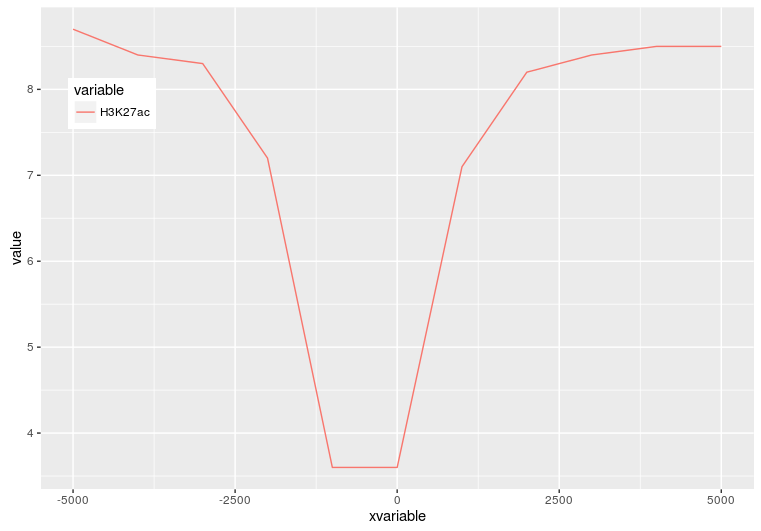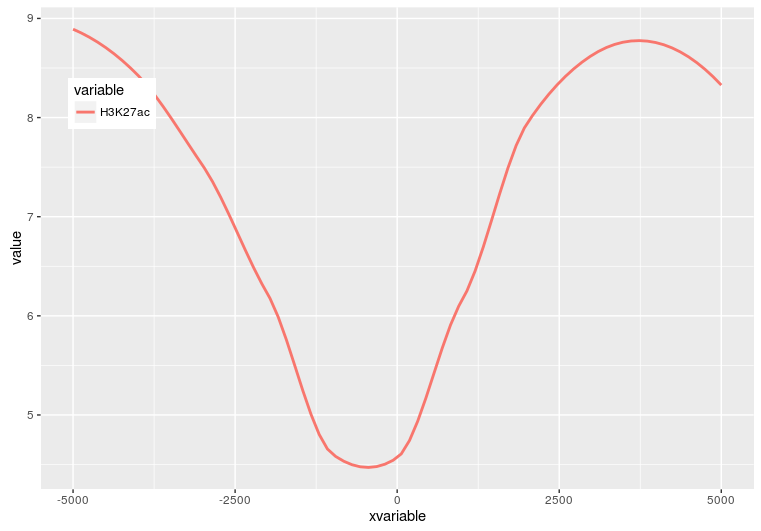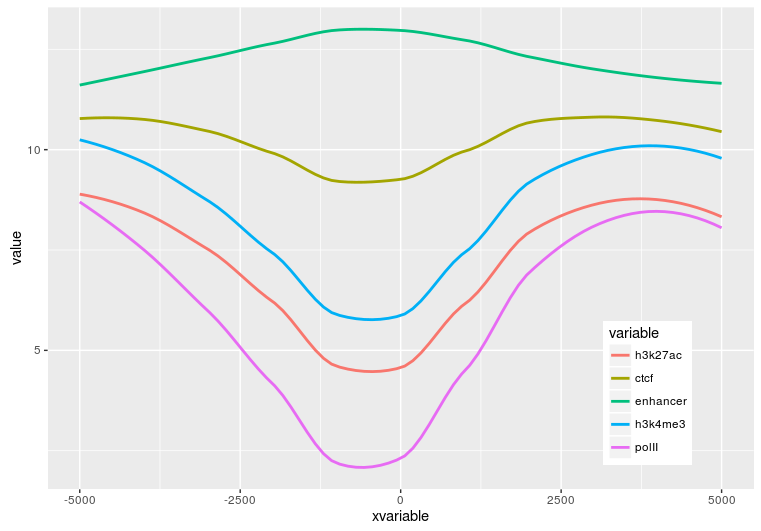线图是反映趋势变化的一种方式,其输入数据一般也是一个矩阵。
单线图
假设有这么一个矩阵,第一列为转录起始位点及其上下游5 kb的区域,第二列为H3K27ac修饰在这些区域的丰度,想绘制一张线图展示。
profile="Pos;H3K27ac -5000;8.7 -4000;8.4 -3000;8.3 -2000;7.2 -1000;3.6 0;3.6 1000;7.1 2000;8.2 3000;8.4 4000;8.5 5000;8.5"
读入数据
profile_text <- read.table(text=profile, header=T, row.names=1, quote="",sep=";")
# 在melt时保留位置信息
# melt格式是ggplot2画图最喜欢的格式
# 好好体会下这个格式,虽然多占用了不少空间,但是确实很方便
# 这里可以用 `xvariable`,也可以是其它字符串,但需要保证后面与这里的一致
# 因为这一列是要在X轴显示,所以起名为`xvariable`。
profile_text$xvariable = rownames(profile_text)
library(ggplot2)
library(reshape2)
data_m <- melt(profile_text, id.vars=c("xvariable"))
data_m
xvariable variable value
1 -5000 H3K27ac 8.7
2 -4000 H3K27ac 8.4
3 -3000 H3K27ac 8.3
4 -2000 H3K27ac 7.2
5 -1000 H3K27ac 3.6
6 0 H3K27ac 3.6
7 1000 H3K27ac 7.1
8 2000 H3K27ac 8.2
9 3000 H3K27ac 8.4
10 4000 H3K27ac 8.5
11 5000 H3K27ac 8.5
然后开始画图,与画heatmap一样。
# variable和value为矩阵melt后的两列的名字,内部变量, variable代表了点线的属性,value代表对应的值。 p <- ggplot(data_m, aes(x=xvariable, y=value), color=variable) + geom_line() # 图会存储在当前目录的Rplots.pdf文件中,如果用Rstudio,可以不运行dev.off() dev.off()
满心期待一个倒钟形曲线,结果出错了。仔细看,出来一段提示
geom_path: Each group consists of only one observation.Do you need to adjust the group aesthetic?
原来默认ggplot2把每个点都视作了一个分组,什么都没画出来。而data_m中的数据都来源于一个分组H3K27ac,分组的名字为variable,修改下脚本,看看效果。
p <- ggplot(data_m, aes(x=xvariable, y=value, color=variable, group=variable)) + geom_line() + theme(legend.position=c(0.1,0.9)) p
图出来了,一条线,看一眼没问题;再仔细看,不对了,怎么还不是倒钟形,原来横坐标错位了。
检查下数据格式
summary(data_m) xvariable variable Length:11 H3K27ac:11 Class :character Mode :character
问题来了,xvariable虽然看上去像数字,但存储的实际是字符串 (因为是作为行名字读取的),需要转换为数字。
data_m$xvariable <- as.numeric(data_m$xvariable) #再检验下 is.numeric(data_m$xvariable) [1] TRUE
好了,继续画图。
# 注意断行时,加号在行尾,不能放在行首
p <- ggplot(data_m, aes(x=xvariable, y=value,color=variable,group=variable)) +
geom_line() + theme(legend.position=c(0.1,0.8))
p
图终于出来了,调了下legend的位置,看上去有点意思了

有点难看,如果平滑下,会不会好一些,stat_smooth可以对绘制的线进行局部拟合。在不影响变化趋势的情况下,可以使用 (但慎用)。
p <- ggplot(data_m, aes(x=xvariable, y=value,color=variable,group=variable)) +
geom_line() + stat_smooth(method="auto", se=FALSE) +
theme(legend.position=c(0.1,0.8))
p
从图中看,趋势还是一致的,线条更优美了。另外一个方式是增加区间的数量,线也会好些,而且更真实。
stat_smooth和geom_line各绘制了一条线,只保留一条就好。
p <- ggplot(data_m, aes(x=xvariable, y=value,color=variable,group=variable)) +
stat_smooth(method="auto", se=FALSE) + theme(legend.position=c(0.1,0.8))
p
好了,终于完成了单条线图的绘制

多线图
那么再来一个多线图的例子吧,只要给之前的数据矩阵多加几列就好了。
profile = "Pos;h3k27ac;ctcf;enhancer;h3k4me3;polII
-5000;8.7;10.7;11.7;10;8.3
-4000;8.4;10.8;11.8;9.8;7.8
-3000;8.3;10.5;12.2;9.4;7
-2000;7.2;10.9;12.7;8.4;4.8
-1000;3.6;8.5;12.8;4.8;1.3
0;3.6;8.5;13.4;5.2;1.5
1000;7.1;10.9;12.4;8.1;4.9
2000;8.2;10.7;12.4;9.5;7.7
3000;8.4;10.4;12;9.8;7.9
4000;8.5;10.6;11.7;9.7;8.2
5000;8.5;10.6;11.7;10;8.2"
profile_text <- read.table(text=profile, header=T, row.names=1, quote="",sep=";")
profile_text$xvariable = rownames(profile_text)
data_m <- melt(profile_text, id.vars=c("xvariable"))
data_m$xvariable <- as.numeric(data_m$xvariable)
# 这里group=variable,而不是group=1 (如果上面你用的是1的话)
# variable和value为矩阵melt后的两列的名字,内部变量, variable代表了点线的属性,value代表对应的值。
p <- ggplot(data_m, aes(x=xvariable, y=value,color=variable,group=variable)) + stat_smooth(method="auto", se=FALSE) + theme(legend.position=c(0.85,0.2))
p

横轴文本线图
如果横轴是文本,又该怎么调整顺序呢?还记得之前热图旁的行或列的顺序调整吗?重新设置变量的factor水平就可以控制其顺序。
profile = "Pos;h3k27ac;ctcf;enhancer;h3k4me3;polII
-5000;8.7;10.7;11.7;10;8.3
-4000;8.4;10.8;11.8;9.8;7.8
-3000;8.3;10.5;12.2;9.4;7
-2000;7.2;10.9;12.7;8.4;4.8
-1000;3.6;8.5;12.8;4.8;1.3
0;3.6;8.5;13.4;5.2;1.5
1000;7.1;10.9;12.4;8.1;4.9
2000;8.2;10.7;12.4;9.5;7.7
3000;8.4;10.4;12;9.8;7.9
4000;8.5;10.6;11.7;9.7;8.2
5000;8.5;10.6;11.7;10;8.2"
profile_text <- read.table(text=profile, header=T, row.names=1, quote="",sep=";")
profile_text_rownames <- row.names(profile_text)
profile_text$xvariable = rownames(profile_text)
data_m <- melt(profile_text, id.vars=c("xvariable"))
# 就是这一句,会经常用到
data_m$xvariable <- factor(data_m$xvariable, levels=profile_text_rownames, ordered=T)
# geom_line设置线的粗细和透明度
p <- ggplot(data_m, aes(x=xvariable, y=value,color=variable,group=variable)) + geom_line(size=1, alpha=0.9) + theme(legend.position=c(0.85,0.2)) + theme(axis.text.x=element_text(angle=45,hjust=1, vjust=1))
# stat_smooth
#p <- ggplot(data_m, aes(x=xvariable, y=value,color=variable,group=variable)) + stat_smooth(method="auto", se=FALSE) + theme(legend.position=c(0.85,0.2)) + theme(axis.text.x=element_text(angle=45,hjust=1, vjust=1))
p
比较下位置信息做为数字(前面的线图)和位置信息横轴的差别。当为数值时,ggplot2会选择合适的几个刻度做标记,当为文本时,会全部标记。另外文本横轴,smooth效果不明显
到此完成了线图的基本绘制,虽然还可以,但还有不少需要提高的地方,比如在线图上加一条或几条垂线、加个水平线、修改X轴的标记(比如0换为TSS)、设置每条线的颜色等。